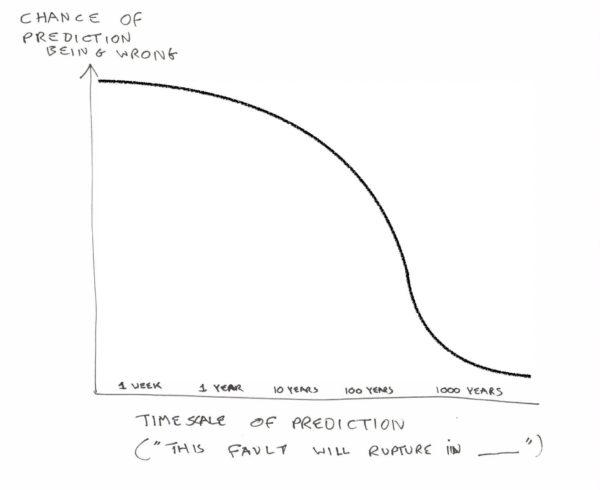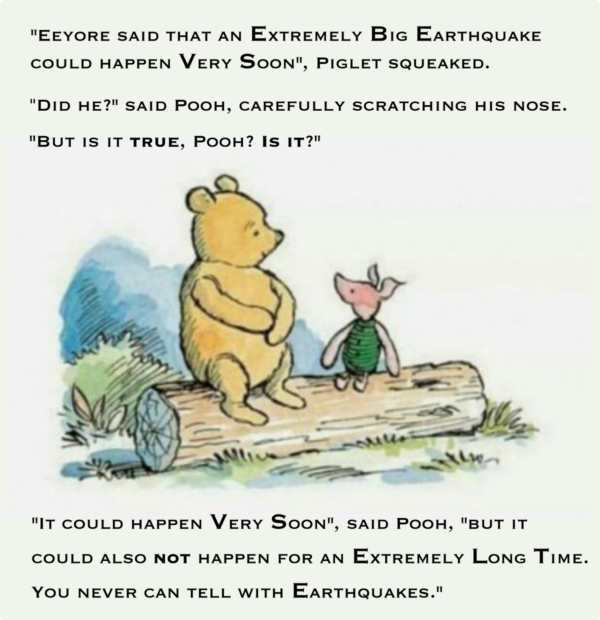If you want to make earthquake scientists jumpy, all you need to do is ask, "can you predict the next earthquake?"
In fact, any variation on the theme of ‘earthquake’ and ‘prediction’ will do – unless it is one which informs you that their combination is impossible.

Use of the word ‘prediction’ implies precise knowledge about an upcoming event, both in space and in time: we think that fault will fail, in an earthquake so big, over this timeframe. But such specificity is exactly what we don’t have, and may never have, when we’re considering the future risk of large earthquakes.
In a geological echo of the uncertainty principle, we can only narrow down the location of a future earthquake if we are very fuzzy about the timeframe over which it will occur, and we can only talk with any confidence about a specific period in which an earthquake of a particular size will occur by greatly expanding the area of the planet we are considering. So we can ‘predict’ there will be a magnitude 6 or greater earthquake somewhere in the world in the next fortnight. We can ‘predict’ that the San Andreas Fault will rupture at some point in the next 250 years. But neither of these predictions are useful: we don’t know even roughly where in the world that magnitude 6 will occur, let alone which fault will rupture to produce it. And we don’t know when in the next 250 years the San Andreas will rupture. It could be tomorrow; it could be two centuries from now; it could be any point in between.
If we confine ourselves geographically to a particular fault or collection of faults, there are two specific timeframes over which a bona fide prediction would be actionable, giving us the chance to meaningfully act to mitigate the worst of the damage and devastation. One is short – days to weeks. If we knew that there was going to be a major rupture on a particular fault in the next few days or weeks, we could evacuate the area at risk, and disaster response could be ramped up in advance of the inevitable damage and casualties. This is the realm of claimed earthquake precursors – a subject which I have written about many, many, many, many times. At best, we don’t understand enough to interpret potential precursor signals ahead of time. At worst, large earthquakes don’t actually generate precursors, because they’re just small earthquakes that happened to keep going.
The other useful timescale is longer. If we could make confident predictions about a major fault rupture in the next few decades, then that could inform specific decisions about where to build the most resilient infrastructure, which populations need to be prepared, and how to train emergency personnel. Unfortunately, the behaviour of faults is highly variable over precisely the sort of 50-100* year timescales that would be useful to us. In places where we can use paleoseismology – the study of the geological record left by earthquakes – to construct a history of multiple large earthquakes over hundreds or thousands of years, we see quasi-periodic behaviour: the average interval between dozens of earthquakes often remains fairly constant, but the interval between any two earthquakes can vary quite significantly from that average. A couple of examples:
- An 8000-year record for the Alpine Fault in New Zealand found 24 large events with an estimated mean recurrence interval (time between earthquakes) of 329 years, with individual gaps ranging from 140 to 510 years.
- The average recurrence interval of 29 large earthquakes over 3000 years at a site on the southern San Andreas fault is estimated at 86 years, but individual gaps between subsequent ruptures can be less than 50 years, or more than 150.
Earthquakes can never really be ‘overdue’, because they don’t have a fixed schedule. All we can say for sure is that an active fault will rupture eventually. If scientists have done the hard work of reconstructing the paleoseismic record, we may also know that over many events, the average time gap between them is so many years. But because the gap between individual large earthquakes on a fault can vary by a century or more, we cannot truly know for sure if there is going to be a major earthquake in the next 50 years. This uncertainty will always be with us: it is a fundamental aspect of how large earthquakes seem to work. And, as such, making specific predictions about when the next big earthquake will strike is folly – arguably, even attempting to do so is dangerously misleading, because it tacitly accepts the premise that such a thing is possible, when it isn’t.

Our certainty about an earthquake occurring within a particular timeframe is only high over periods of centuries or more. For anything less, our prediction has a very high chance of being wrong.
Rather than stating that a large earthquake will definitely happen (or not) in the next 50 years, earthquake scientists must instead grapple with the uncertainties in fault behaviour and estimate the 50 (or 25, or 100) year probability of such an event occurring. Using our knowledge of a fault’s past behaviour, and our assumptions about how deformation in the crust works, we ask the question: if we could run the next 50 years multiple times, how often would we see a big quake?
This approach has it’s limitations. Our knowledge and understanding of the system is not complete, and different assumptions can lead to very different estimated probabilities (here is a good start for understanding these issues). People are also exceedingly bad at interpreting probabilities correctly, particularly in cases such as this: we only get to live through the next 50 years once, and for a single roll of the seismic dice, although certain outcomes are more likely, any scenario with a non-zero probability could happen.
That is not to say these forecasts should be ignored. They represent our current best guess about the seismic risks a region faces, and are a valuable starting point for preparing to meet them. But their core message is that the dice exists, and bad rolls are possible. Even if we don’t know exactly how many sides spell bad things for us, we know that some of them do, and we should prepare accordingly. We don’t know when in the next few hundred years the San Andreas Fault, the Alpine Fault, or the Cascadia subduction zone will rupture, just that they will. We must prepare like it might be tomorrow, and not be surprised if it is instead two centuries from now. With faults, you never can tell which it will be.
* 50 years – the interval for which we generally construct seismic hazard maps – is the average lifetime of a building.




Comments (2)